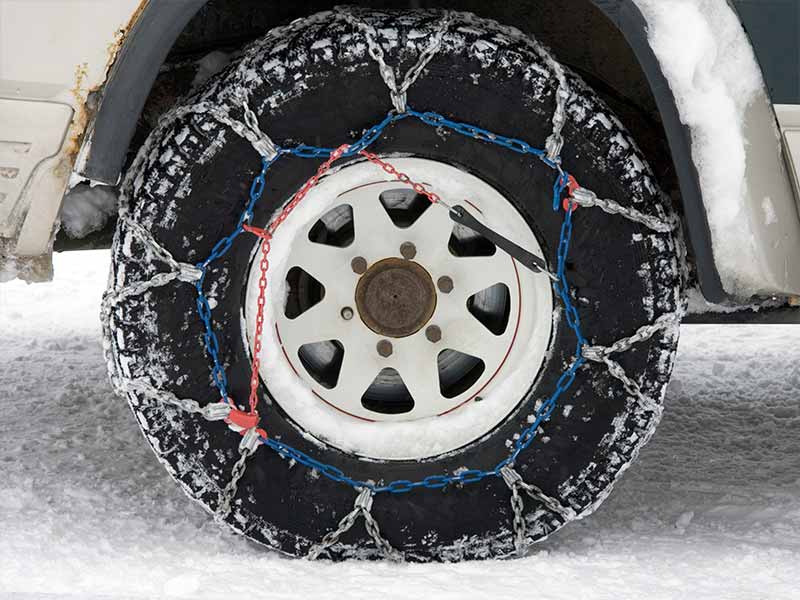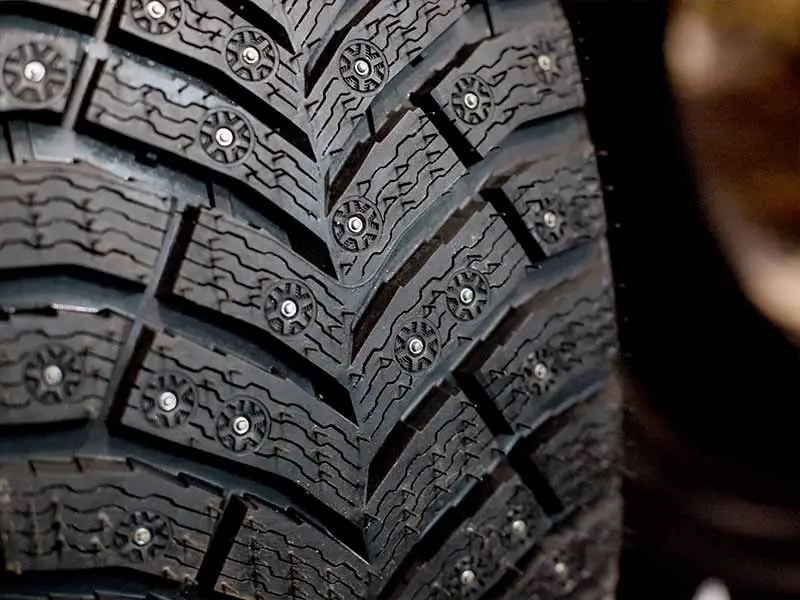Are you often confused about when to use snow chains or stick to regular snow tires? Discover the precise conditions that warrant the use of tire chains on snow-covered roads and ensure safe and effective driving in winter weather.
How Many Inches Of Snow Require Chains?
In snowy conditions, the need for tire chains is when there’s approximately 2 to 3 inches or more of accumulated snow on the ground, especially on fully compacted snow or ice-covered roads.
In this article, we’ll delve into the essential considerations regarding when to use tire chains in snowy conditions. We’ll cover everything from understanding chain laws, conditions necessitating tire chains, proper installation and usage guidelines, alternatives to traditional tire chains, considerations for different vehicle types, safety precautions, and best practices.

When to Use Tire Chains on Snowy Roads
Being cautious and informed about when to use tire chains in snowy conditions is pivotal for safe driving. Remember, tire chains aren’t just a winter accessory but a crucial safety measure when facing challenging road conditions. Always prioritize safety while considering the use of tire chains.
Understanding the Need for Tire Chains
Snow Depth Considerations:
- Tire chains are essential when the snow reaches a certain depth. Typically, it’s recommended to consider using chains when there’s an accumulation of around 2 to 3 inches of snow on the ground.
- If you’re unsure about the exact depth requirements for your specific vehicle or driving conditions, consult your vehicle’s manual or reach out to a reliable tire professional.
Assessing Road Conditions:
- The decision to use tire chains also depends on the road conditions. If the roads are compacted with snow or covered in ice, it’s an indication that tire chains might be necessary.
- However, avoid using chains on roads that have been cleared or treated. This not only helps preserve the road surface but also prevents unnecessary wear on your tire chains.
Exceptions and Legal Considerations
Chain Control Areas and State Laws:
- In some regions, chain control areas might have specific laws or requirements mandating the use of tire chains under certain conditions.
- It’s crucial to be aware of these laws and adhere to them to avoid fines or penalties. Check your local regulations or refer to resources like state-specific tire chain laws to ensure compliance.
Speed and Safety:
- When using tire chains, it’s vital to adhere to safe driving practices. Avoid driving over 30 mph with chains on, as higher speeds can compromise your vehicle’s control and the chains’ integrity.
- Only use tire chains when absolutely necessary for safety. If driving without chains is possible without risking safety, it’s best to avoid using them.
Vehicle-Specific Considerations
Four-Wheel Drive (4WD) and All-Wheel Drive (AWD) Vehicles:
- While these vehicles generally offer better traction in snowy conditions, they aren’t exempt from needing tire chains. Even with 4WD or AWD, tire chains might be necessary in severe snow or ice.
- Learn more about the necessity of tire chains for AWD vehicles or 2-wheel drive vehicles for additional guidance.
These guidelines aim to empower you with the necessary knowledge about when and how to use tire chains effectively in snowy conditions. For more information on the differences between tire chains and studded tires, explore studded tires vs. chains or snow tires vs. chains for a deeper understanding of winter traction options.
| State | Tire Chains Allowed? | Restrictions (if any) |
|---|---|---|
| Alabama | Yes | No specific restrictions* |
| Arizona | Yes | No specific restrictions* |
| California | Yes | Signs posted when required |
| Colorado | Yes | Commercial vehicles carry chains from Sept 1 – May 31 |
| Connecticut | Yes (Studded tires & non-skid devices from Nov 15 – April 30) | Specific dates for studded tires & non-skid devices |
| Delaware | Yes | No specific restrictions* |
| Florida | Yes | No specific laws |
| Georgia | Yes | No specific restrictions* |
| Hawaii | Yes | No specific laws |
| Idaho | Yes | No specific restrictions advised unless necessary |
| Illinois | Yes | No specific restrictions* |
| Indiana | Yes | No specific restrictions* |
| Iowa | Yes | No specific restrictions* |
| Kansas | Yes | No specific restrictions* |
| Kentucky | Yes (Ice-covered roads or vehicles with ice shoes 6 in wide) | Restrictions on diameter & spacing |
| Louisiana | Yes | No specific restrictions* |
| Maine | Yes | No specific restrictions* |
| Maryland | Yes (Required when a snow emergency has been declared) | Not allowed on vehicles weighing more than 10,000 lbs |
| Massachusetts | Yes | Permitted from Nov 1-May 1 |
| Michigan | Yes | No specific restrictions* |
| Minnesota | Yes (Permitted when road conditions call for it) | Studded pneumatic tires not allowed on state-registered vehicles |
| Mississippi | Yes | No specific restrictions* |
| Missouri | Yes | No specific laws |
| Montana | Yes (Permitted Oct 1-May 1) | Not mandatory unless notices are posted. Specific regulations for studded tires. |
| Nebraska | Yes (Metal studs only permitted Nov 1-April 1) | School buses, mail carrier vehicles, and emergency vehicles permitted year-round |
| Nevada | Yes (Required on all vehicles over 10,000 lbs when requirements in effect) | Studded tires permitted between Oct 1-April 30 |
| New Hampshire | Yes | No specific laws |
| New Jersey | Yes | No specific restrictions* |
| New York | Yes | Required when a snow emergency has been declared |
| New Mexico | Yes | No specific restrictions* |
| North Carolina | Yes | No specific restrictions* |
| North Dakota | Yes | No specific restrictions* |
| Ohio | Yes (Only permitted between Nov 1-April 1, except for public safety or school bus) | |
| Oklahoma | Yes | No specific restrictions* |
| Oregon | Yes (Required on vehicles over 10,000 lbs when SNOW ZONE signs are posted) | |
| Pennsylvania | Yes (Permitted between Nov 1-April 15) | Restrictions on the size of tires or studs |
| Rhode Island | Yes | No specific restrictions* |
| South Carolina | Yes | No specific restrictions* |
| South Dakota | Yes | No specific restrictions* |
| Tennessee | Yes (Permitted Oct 1-April 1) | Specific regulations on a percentage of wire or other material that comes in contact with the road |
| Texas | Yes | No specific restrictions* |
| Utah | Yes (Between Nov 1-March 31, if signs are posted, vehicles must have chains or snow tires) | |
| Vermont | Yes | No specific laws |
| Washington | Yes (Signs marked “chains required” will be posted) | On certain routes, chains must be carried from Nov 1-Mar 31 |
| Washington, D.C. | Yes | No specific laws |
| West Virginia | Yes | No specific restrictions* |
| Wisconsin | Yes | No specific restrictions* |
| Wyoming | Yes (Signs will be posted indicating when chain laws are in effect) | Must use adequate snow tires or chains |
*Some states have date restrictions, size restrictions, or specific vehicle type restrictions. Check with the state’s transportation department for specifics.
Understanding Chain Laws and Legal Requirements
Understanding chain laws and legal requirements regarding tire chains is essential for safe and lawful driving in snowy conditions. By adhering to these regulations, not only do you ensure your safety, but you also contribute to maintaining road integrity.
Overview of Chain Laws
State-Specific Regulations:
- Different states have varying laws concerning the use of tire chains in snowy conditions. Some states might require the use of chains under specific circumstances, while others may prohibit or restrict their use altogether.
- Check out state-specific tire chain laws to familiarize yourself with the regulations in your area.
Chain Mandates in Chain Control Areas:
- Chain control areas are zones designated by authorities where chain requirements are strictly enforced during severe weather conditions.
- Understand the rules in these areas and abide by them to prevent legal repercussions and ensure road safety.
States Where Tire Chains Are Restricted or Prohibited
Prohibited Areas:
- Some states don’t allow the use of tire chains due to their impact on road surfaces or other safety concerns.
- Familiarize yourself with areas where tire chains are illegal to avoid legal issues and maintain road integrity.
Penalties for Non-Compliance:
- Ignoring chain laws can result in fines, penalties, or even vehicle impoundment in certain regions.
- To steer clear of legal troubles, it’s crucial to understand and adhere to the chain laws in your state or any state you plan to travel through.
Importance of Following Chain Laws
Road Safety and Preservation:
- Chain laws aren’t arbitrary; they’re designed to ensure safety for all road users. Using chains when required not only enhances your vehicle’s traction but also reduces accidents in snowy conditions.
- Additionally, it prevents unnecessary wear on road surfaces, contributing to road preservation efforts.
Remember to stay informed about chain laws in your area and any areas you plan to travel through. For more insights into the differences in tire chain requirements for different vehicles, explore further resources on how many snow chains are needed for AWD or 2-wheel drive vehicles.

Proper Installation and Usage of Tire Chains
Proper installation, adjustment, and maintenance of tire chains are vital for safe and effective use in snowy conditions. Follow these step-by-step guidelines to ensure optimal performance and safety when using tire chains.
Step-by-Step Installation Guide
Preparation and Placement:
- Lay out the chains on the ground and ensure they are tangle-free before placing them on the drive wheels of your vehicle. Refer to your vehicle’s manual for the appropriate wheels to install the chains on.
- Securely fasten the chains over the tire treads, making sure they are snug and evenly placed.
Adjustment and Tension:
- Drive a short distance after installing the chains to settle them in place. Then, stop and recheck the tension. Chains might loosen initially and may need readjustment for a proper fit.
- Ensure the chains are neither too tight nor too loose. Proper tension ensures maximum traction without damaging the tires.
Maintenance and Safety Considerations
Stopping to Adjust Chains:
- Periodically stop to recheck the tension of the chains, especially after driving a short distance. Loose chains can compromise traction and pose safety hazards.
- If the chains become loose during travel, pull over in a safe location to readjust them before continuing.
Speed Limits and Road Conditions:
- Adhere to recommended speed limits while driving with tire chains. Driving over 30 mph can decrease control and lead to accidents.
- Additionally, avoid using tire chains on cleared or treated roads to prevent damage to both the chains and the road surface.
Removing and Storing Chains
Removing Chains Properly:
- Once you’re on cleared roads or no longer require the chains, safely pull over to remove them. Drive a short distance without the chains to settle your vehicle’s handling.
- Remove the tire chains by following the instructions in reverse order of installation.
Storing Chains for Future Use:
- Clean and dry the tire chains before storing them to prevent rust or deterioration.
- Proper storage in a dry and secure place ensures they’re ready for use when needed again.

Alternatives to Traditional Tire Chains
Exploring alternatives to traditional tire chains, such as snow socks, cable chains, and studded tires, offers a spectrum of options for improved traction in snowy conditions. Each alternative has its benefits and limitations, catering to various driving needs.
Snow Socks as Traction Devices
Understanding Snow Socks:
- Snow socks are fabric-based covers that slip over tires to enhance traction on snow and ice. They are lightweight, easy to install, and suitable for occasional use.
- These socks offer an alternative to traditional tire chains and are particularly useful for vehicles with limited clearance around the wheel.
Benefits and Considerations:
- Snow socks provide decent traction on snowy surfaces while being gentler on road surfaces compared to metal chains.
- However, they might not offer the same level of traction as chains in extreme conditions or on steep inclines.
Cable Chains for Enhanced Traction
Understanding Cable Chains:
- Cable chains are metal chains encased in steel rollers, providing improved traction on snow and ice.
- These chains are relatively easier to install than traditional tire chains and offer better compatibility with vehicles that have limited clearance.
Benefits and Limitations:
- Cable chains strike a balance between traction and a smoother ride compared to traditional chains, making them suitable for various driving conditions.
- However, they might not provide the same level of traction as heavy-duty chains in severe or icy conditions.
Studded Tires as an Alternative
Introduction to Studded Tires:
- Studded tires have metal studs embedded in the tire treads, offering enhanced grip on icy surfaces.
- They provide excellent traction in icy conditions, making them a viable alternative to traditional tire chains.
Considerations and Restrictions:
- Studded tires excel in icy conditions but might not be as effective in deep snow or on dry roads.
- Some regions have restrictions on studded tire usage due to their potential impact on road surfaces.
Resources
Below are some links you may find helpful when learning about tires:
Final Thoughts
While it’s smart to carry chains, even with all wheel drive vehicles, understanding when to have your chains installed in severe winter weather is important for safe snow driving. Always adhere to snow chain laws, assess road conditions, and install chains properly.
Remember, safety is paramount—prioritize caution and responsible driving to ensure a safe and enjoyable winter driving experience.
Good luck and happy motoring.





